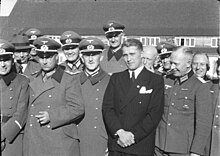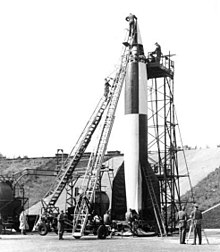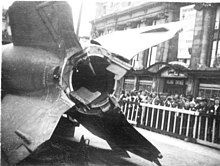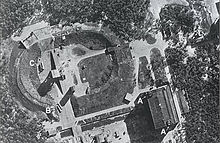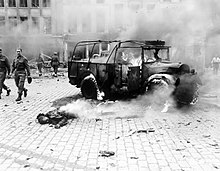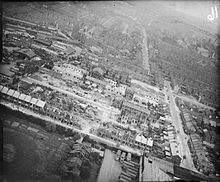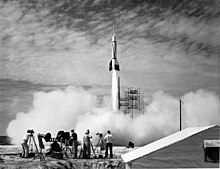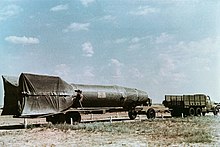| Aggregat-4 / Vergeltungswaffe-2 | |
|---|---|
 Peenemünde Museum replica of V-2 | |
| Type | Single-stage ballistic missile |
| Place of origin | Germany |
| Service history | |
| In service | 1944–1952 |
| Used by | |
| Production history | |
| Designer | Peenemünde Army Research Center |
| Manufacturer | Mittelwerk GmbH |
| Unit cost |
|
| Produced |
|
| No. built | over 3,000 |
| Specifications | |
| Mass | 12,500 kg (27,600 lb) |
| Length | 14 m (45 ft 11 in) |
| Diameter | 1.65 m (5 ft 5 in) |
| Warhead | 1,000 kg (2,200 lb); Amatol (explosive weight: 910 kg) |
Detonation mechanism | Impact |
| Wingspan | 3.56 m (11 ft 8 in) |
| Propellant |
|
Operational range | 320 km (200 mi) |
| Flight altitude |
|
| Maximum speed |
|
Guidance system |
|
Launch platform | Mobile (Meillerwagen) |
The V-2 (German: Vergeltungswaffe 2, "Retribution Weapon 2"), with the technical name Aggregat 4 (A4), was the world's first long-range guided ballistic missile. The missile, powered by a liquid-propellant rocket engine, was developed during the Second World War in Germany as a "vengeance weapon" and assigned to attack Allied cities as retaliation for the Allied bombings against German cities. The V-2 rocket also became the first artificial object to travel into space by crossing the Kármán line with the vertical launch of MW 18014 on 20 June 1944.
Research into military use of long-range rockets began when the graduate studies of Wernher von Braun attracted the attention of the German Army. A series of prototypes culminated in the A-4, which went to war as the V-2. Beginning in September 1944, over 3,000 V-2s were launched by the German Wehrmacht against Allied targets, first London and later Antwerp and Liège. According to a 2011 BBC documentary, the attacks from V-2s resulted in the deaths of an estimated 9,000 civilians and military personnel, and a further 12,000 forced laborers and concentration camp prisoners died as a result of their forced participation in the production of the weapons.
The rockets travelled at supersonic speed, impacted without audible warning, and proved unstoppable, as no effective defense existed. Teams from the Allied forces—the United States, the United Kingdom, and the Soviet Union—raced to seize key German manufacturing facilities, procure Germany's missile technology, and capture the V-2's launching sites. Von Braun and over 100 key V-2 personnel surrendered to the Americans, and many of the original V-2 team ended up working at the Redstone Arsenal. The US also captured enough V-2 hardware to build approximately 80 of the missiles. The Soviets gained possession of the V-2 manufacturing facilities after the war, re-established V-2 production, and moved it to the Soviet Union.
Development history
In the late 1920s, a young Wernher von Braun bought a copy of Hermann Oberth's book, Die Rakete zu den Planetenräumen (The Rocket into Interplanetary Spaces). The world's first large-scale experimental rocket program was Opel RAK under the leadership of Fritz von Opel and Max Valier, a collaborator of Oberth, during the late 1920s leading to the first manned rocket cars and rocket planes, which paved the way for the Nazi era V2 program and US and Soviet activities from 1950 onwards. The Opel RAK program and the spectacular public demonstrations of ground and air vehicles drew large crowds, as well as caused global public excitement as so-called "Rocket Rumble" and had a large long-lasting impact on later spaceflight pioneers, in particular on Wernher von Braun. The Great Depression ended these activities. Von Opel left Germany in 1930 and emigrated later to France and Switzerland.
Starting in 1930, von Braun attended the Technical University of Berlin, where he assisted Oberth in liquid-fueled rocket motor tests. Von Braun was working on his doctorate when the Nazi Party gained power in Germany. An artillery captain, Walter Dornberger, arranged an Ordnance Department research grant for von Braun, who from then on worked next to Dornberger's existing solid-fuel rocket test site at Kummersdorf. Von Braun's thesis, Construction, Theoretical, and Experimental Solution to the Problem of the Liquid Propellant Rocket (dated 16 April 1934), was kept classified by the German Army and was not published until 1960. By the end of 1934, his group had successfully launched two rockets that reached heights of 2.2 and 3.5 km (1.4 and 2.2 mi).
At the time, Germany was highly interested in American physicist Robert H. Goddard's research. Before 1939, German engineers and scientists occasionally contacted Goddard directly with technical questions. Von Braun used Goddard's plans from various journals and incorporated them into the building of the Aggregate (A) series of rockets, named for the German word for mechanism or mechanical system.
Following successes at Kummersdorf with the first two Aggregate series rockets, Braun and Walter Riedel began thinking of a much larger rocket in the summer of 1936, based on a projected 25,000 kg (55,000 lb) thrust engine. In addition, Dornberger specified the military requirements needed to include a 1-ton payload, a range of 172 miles with a dispersion of 2 or 3 miles, and transportable using road vehicles.
After the A-4 project was postponed due to unfavorable aerodynamic stability testing of the A-3 in July 1936, Braun specified the A-4 performance in 1937, and, after an "extensive" series of test firings of the A-5 scale test model, using a motor redesigned from the troublesome A-3 by Walter Thiel, A-4 design and construction was ordered c. 1938–39. During 28–30 September 1939, Der Tag der Weisheit (English: The Day of Wisdom) conference met at Peenemünde to initiate the funding of university research to solve rocket problems.
By late 1941, the Army Research Center at Peenemünde possessed the technologies essential to the success of the A-4. The four key technologies for the A-4 were large liquid-fuel rocket engines, supersonic aerodynamics, gyroscopic guidance and rudders in jet control. At the time, Adolf Hitler was not particularly impressed by the V-2; he opined that it was merely an artillery shell with a longer range and much higher cost.
In early September 1943, Braun promised the Long-Range Bombardment Commission that the A-4 development was "practically complete/concluded", but even by the middle of 1944, a complete A-4 parts list was still unavailable. Hitler was sufficiently impressed by the enthusiasm of its developers, and needed a "wonder weapon" to maintain German morale, so he authorized its deployment in large numbers.
The V-2s were constructed at the Mittelwerk site by prisoners from Mittelbau-Dora, a concentration camp where 12,000–20,000 prisoners died during the war.
In 1943 the Austrian resistance group around Heinrich Maier managed to send exact drawings of the V-2 rocket to the American Office of Strategic Services. Location sketches of V-rocket manufacturing facilities, such as those in Peenemünde, were also sent to the Allied general staff in order to enable Allied bombers to carry out airstrikes. This information was particularly important for Operation Crossbow and Operation Hydra, both preliminary missions for Operation Overlord. The group was gradually captured by the Gestapo and most of the members were executed.
Technical details
The A-4 used a 75% ethanol/25% water mixture (B-Stoff) for fuel and liquid oxygen (LOX) (A-Stoff) for oxidizer. The water reduced the flame temperature, acted as a coolant by turning to steam and augmented the thrust, tended to produce a smoother burn, and reduced thermal stress.
Rudolf Hermann's supersonic wind tunnel was used to measure the A-4's aerodynamic characteristics and center of pressure, using a model of the A-4 within a 40 square centimeter chamber. Measurements were made using a Mach 1.86 blowdown nozzle on 8 August 1940. Tests at Mach numbers 1.56 and 2.5 were made after 24 September 1940.
At launch the A-4 propelled itself for up to 65 seconds on its own power, and a program motor held the inclination at the specified angle until engine shutdown, after which the rocket continued on a ballistic free-fall trajectory. The rocket reached a height of 80 km (50 mi) or 264,000 ft after shutting off the engine.
The fuel and oxidizer pumps were driven by a steam turbine, and the steam was produced by concentrated hydrogen peroxide (T-Stoff) with sodium permanganate (Z-Stoff) catalyst. Both the alcohol and oxygen tanks were an aluminum-magnesium alloy.
The turbopump, rotating at 4000 rpm, forced the alcohol and oxygen into the combustion chamber at 125 liters (33 US gallons) per second, where they were ignited by a spinning electrical igniter. Thrust increased from 8 tons during this preliminary stage whilst the fuel was gravity-fed, before increasing to 25 tons as the turbopump pressurised the fuel, lifting the 13.5 ton rocket. Combustion gases exited the chamber at 5,100 °F (2,820 °C), and a speed of 2000 m (6500 feet) per second. The oxygen to fuel mixture was 1.0:0.85 at 25 tons of thrust, but as ambient pressure decreased with flight altitude, thrust increased until it reached 29 tons. The turbopump assembly contained two centrifugal pumps, one for the alcohol, and one for the oxygen, both connected to a common shaft. Hydrogen peroxide converted to steam, using a sodium permanganate catalyst powered the pump, which delivered 55 kg (120 pounds) of alcohol and 68 kg (150 pounds) of liquid oxygen per second to a combustion chamber at 1.5 MPa (210 psi).
Dr. Thiel's development of the 25 ton rocket motor relied on pump feeding, rather than on the earlier pressure feeding. The motor used centrifugal injection, while using both regenerative cooling and film cooling. Film cooling admitted alcohol into the combustion chamber and exhaust nozzle under slight pressure through four rings of small perforations. The mushroom-shaped injection head was removed from the combustion chamber to a mixing chamber, the combustion chamber was made more spherical while being shortened from 6 to 1 foot in length, and the connection to the nozzle was made cone shaped. The resultant 1.5 ton chamber operated at a combustion pressure of 1.52 MPa (220 pounds per square inch). Thiel's 1.5 ton chamber was then scaled up to a 4.5 ton motor by arranging three injection heads above the combustion chamber. By 1939, eighteen injection heads in two concentric circles at the head of the 3 mm (0.12-inch) thick sheet-steel chamber, were used to make the 25 ton motor.
The warhead was another source of troubles. The explosive employed was amatol 60/40 detonated by an electric contact fuze. Amatol had the advantage of stability, and the warhead was protected by a thick layer of glass wool, but even so it could still explode in the re-entry phase. The warhead weighed 975 kilograms (2,150 lb) and contained 910 kilograms (2,010 lb) of explosive. The warhead's percentage by weight that was explosive was 93%, a very high percentage when compared with other types of munition.
The protective layer was used for the fuel tanks as well and the A-4 did not have the tendency to form ice, which had plagued other early missiles (like the balloon tank-design SM-65 Atlas). The tanks held 4,173 kilograms (9,200 lb) of ethyl alcohol and 5,553 kilograms (12,242 lb) of oxygen.
The V-2 was guided by four external rudders on the tail fins, and four internal graphite vanes in the jet stream at the exit of the motor. These 8 control surfaces were controlled by Helmut Hölzer's analog computer, the Mischgerät, via electrical-hydraulic servomotors, based on electrical signals from the gyros. The Siemens Vertikant LEV-3 guidance system consisted of two free gyroscopes (a horizontal for pitch and a vertical with two degrees of freedom for yaw and roll) for lateral stabilization, coupled with a PIGA accelerometer, or the Walter Wolman radio control system, to control engine cutoff at a specified velocity. Other gyroscopic systems used in the A-4 included Kreiselgeräte's SG-66 and SG-70. The V-2 was launched from a pre-surveyed location, so the distance and azimuth to the target were known. Fin 1 of the missile was aligned to the target azimuth.
Some later V-2s used "guide beams", radio signals transmitted from the ground, to keep the missile on course, but the first models used a simple analog computer that adjusted the azimuth for the rocket, and the flying distance was controlled by the timing of the engine cut-off, "Brennschluss", ground controlled by a Doppler system or by different types of on-board integrating accelerometers. Thus, range was a function of engine burn time, which ended when a specific velocity was achieved. Just before engine cutoff, thrust was reduced to 8 tons, in an effort to avoid any water hammer problems a rapid cutoff could cause.
Dr. Friedrich Kirchstein of Siemens of Berlin developed the V-2 radio control for motor-cut-off (German: Brennschluss). For velocity measurement, Professor Wolman of Dresden created an alternative of his Doppler tracking system in 1940–41, which used a ground signal transponded by the A-4 to measure the velocity of the missile. By 9 February 1942, Peenemünde engineer Gerd deBeek had documented the radio interference area of a V-2 as 10,000 metres (33,000 feet) around the "Firing Point", and the first successful A-4 flight on 3 October 1942, used radio control for Brennschluss. Although Hitler commented on 22 September 1943 that "It is a great load off our minds that we have dispensed with the radio guiding-beam; now no opening remains for the British to interfere technically with the missile in flight", about 20% of the operational V-2 launches were beam-guided. The Operation Pinguin V-2 offensive began on 8 September 1944, when Lehr- und Versuchsbatterie No. (English: Training and Testing Battery 444) launched a single rocket guided by a radio beam directed at Paris. Wreckage of combat V-2s occasionally contained the transponder for velocity and fuel cutoff.
The painting of the operational V-2s was mostly a ragged-edged pattern with several variations, but at the end of the war a plain olive green rocket also appeared. During tests the rocket was painted in a characteristic black-and-white chessboard pattern, which aided in determining if the rocket was spinning around its longitudinal axis.
The original German designation of the rocket was "V2", unhyphenated – exactly as used for any Third Reich-era "second prototype" example of an RLM-registered German aircraft design – but U.S. publications such as Life magazine were using the hyphenated form "V-2" as early as December 1944.
Testing
The first successful test flight was on 3 October 1942, reaching an altitude of 84.5 kilometres (52.5 miles). On that day Walter Dornberger declared in a speech at Peenemünde:
This third day of October, 1942, is the first of a new era in transportation, that of space travel...
Two test launches were recovered by the Allies: the Bäckebo rocket, the remnants of which landed in Sweden on 13 June 1944, and one recovered by the Polish resistance on 30 May 1944 from Blizna and transported to the UK during Operation Most III. The highest altitude reached during the war was 174.6 kilometres (108.5 miles) (20 June 1944). Test launches of V-2 rockets were made at Peenemünde, Blizna and Tuchola Forest, and after the war, at Cuxhaven by the British, White Sands Proving Grounds and Cape Canaveral by the U.S., and Kapustin Yar by the USSR.
Various design issues were identified and solved during V-2 development and testing:
- To reduce tank pressure and weight, high flow turbopumps were used to boost pressure.
- A short and lighter combustion chamber without burn-through was developed by using centrifugal injection nozzles, a mixing compartment, and a converging nozzle to the throat for homogeneous combustion.
- Film cooling was used to prevent burn-through at the nozzle throat.
- Relay contacts were made more durable to withstand vibration and prevent thrust cut-off just after lift-off.
- Ensuring that the fuel pipes had tension-free curves reduced the likelihood of explosions at 1,200–1,800 m (4,000–6,000 ft).
- Fins were shaped with clearance to prevent damage as the exhaust jet expanded with altitude.
- To control trajectory at liftoff and supersonic speeds, heat-resistant graphite vanes were used as rudders in the exhaust jet.
Air burst problem
Through mid-March 1944, only four of the 26 successful Blizna launches had satisfactorily reached the Sarnaki target area due to in-flight breakup (Luftzerleger) on re-entry into the atmosphere. (As mentioned above, one rocket was collected by the Home Army, with parts of it transported to London for tests.) Initially, the German developers suspected excessive alcohol tank pressure, but by April 1944, after five months of test firings, the cause was still not determined. Major-General Rossmann, the Army Weapons Office department chief, recommended stationing observers in the target area – c. May/June, Dornberger and von Braun set up a camp at the centre of the Poland target zone. After moving to the Heidekraut, SS Mortar Battery 500 of the 836th Artillery Battalion (Motorized) was ordered on 30 August to begin test launches of eighty 'sleeved' rockets. Testing confirmed that the so-called 'tin trousers' – a tube designed to strengthen the forward end of the rocket cladding – reduced the likelihood of air bursts.
Production
On 27 March 1942, Dornberger proposed production plans and the building of a launching site on the Channel coast. In December, Speer ordered Major Thom and Dr. Steinhoff to reconnoiter the site near Watten. Assembly rooms were established at Peenemünde and in the Friedrichshafen facilities of Zeppelin Works. In 1943, a third factory, Raxwerke, was added.
On 22 December 1942, Hitler signed the order for mass production, when Albert Speer assumed final technical data would be ready by July 1943. However, many issues still remained to be solved even by the autumn of 1943.
On 8 January 1943, Dornberger and von Braun met with Speer. Speer stated, "As head of the Todt organisation I will take it on myself to start at once with the building of the launching site on the Channel coast," and established an A-4 production committee under Degenkolb.
On 26 May 1943, the Long-Range Bombardment Commission, chaired by AEG director Petersen, met at Peenemünde to review the V-1 and V-2 automatic long-range weapons. In attendance were Speer, Air Marshal Erhard Milch, Admiral Karl Dönitz, Col. General Friedrich Fromm, and Karl Saur. Both weapons had reached the stage of development, and the commission decided to recommend to Hitler that both weapons be put into mass production. As Dornberger observed, "The disadvantages of the one would be compensated by the other's advantages."
On 7 July 1943, Major General Dornberger, von Braun, and Dr. Steinhof briefed Hitler in his Wolf's Lair. Also in attendance were Speer, Wilhelm Keitel, and Alfred Jodl. The briefing included von Braun narrating a film showing the successful launch on 3 October 1942, with scale models of the Channel coast firing bunker, and supporting vehicles, including the Meillerwagen. Hitler then gave Peenemünde top priority in the German armaments program stating, "Why was it I could not believe in the success of your work? if we had had these rockets in 1939 we should never have had this war..." Hitler also wanted a second launch bunker built.
Saur planned to build 2000 rockets per month, between the existing three factories and the Nordhausen Mittelwerk factory being built. However, alcohol production was dependent upon the potato harvest.
A production line was nearly ready at Peenemünde when the Operation Hydra attack occurred. The main targets of the attack included the test stands, the development works, the Pre-Production Works, the settlement where the scientists and technicians lived, the Trassenheide camp, and the harbor sector. According to Dornberger, "Serious damage to the works, contrary to first impressions, was surprisingly small." Work resumed after a delay of four to six weeks, and because of camouflage to mimic complete destruction, there were no more raids over the next nine months. The raid resulted in 735 lives lost, with heavy losses at Trassenheide, while 178 were killed in the settlement, including Dr. Thiel, his family, and Chief Engineer Walther. The Germans eventually moved production to the underground Mittelwerk in the Kohnstein where 5,200 V-2 rockets were built with the use of forced labour.
| Period of production | Production |
|---|---|
| Up to 15 September 1944 | 1900 |
| 15 September to 29 October 1944 | 900 |
| 29 October to 24 November 1944 | 600 |
| 24 November to 15 January 1945 | 1100 |
| 15 January to 15 February 1945 | 700 |
| Total | 5200 |
Launch sites
Following Operation Crossbow bombing, initial plans for launching from the massive underground Watten, Wizernes and Sottevast bunkers or from fixed pads such as near the Château du Molay were dropped in favour of mobile launching. Eight main storage dumps were planned and four had been completed by July 1944 (the one at Mery-sur-Oise was begun in August 1943 and completed by February 1944). The missile could be launched practically anywhere, roads running through forests being a particular favourite. The system was so mobile and small that only one Meillerwagen was ever caught in action by Allied aircraft, during the Operation Bodenplatte attack on 1 January 1945 near Lochem by a USAAF 4th Fighter Group aircraft, although Raymond Baxter described flying over a site during a launch and his wingman firing at the missile without hitting it.
It was estimated that a sustained rate of 350 V-2s could be launched per week, with 100 per day at maximum effort, given sufficient supply of the rockets.
Operational history
The LXV Armeekorps z.b.V. formed during the last days of November 1943 in France commanded by General der Artillerie z.V. Erich Heinemann was responsible for the operational use of V-2. Three launch battalions were formed in late 1943, Artillerie Abteilung 836 (Mot.), Grossborn, Artillerie Abteilung 485 (Mot.), Naugard, and Artillerie Abteilung 962 (Mot.). Combat operations commenced in Sept. 1944, when training Batterie 444 deployed. On 2 September 1944, the SS Werfer-Abteilung 500 was formed, and by October, the SS under the command of SS Lt. Gen Hans Kammler, took operational control of all units. He formed Gruppe Sud with Art. Abt. 836, Merzig, and Gruppe Nord with Art. Abt. 485 and Batterie 444, Burgsteinfurt and The Hague.
After Hitler's 29 August 1944 declaration to begin V-2 attacks as soon as possible, the offensive began on 7 September 1944 when two were launched at Paris, but both crashed soon after launch. On 8 September a single rocket was launched at Paris, which caused modest damage near Porte d'Italie. Two more launches by the 485th followed, including one from The Hague against London on the same day at 6:43 pm. – the first landed at Staveley Road, Chiswick, killing 63-year-old Mrs. Ada Harrison, 3-year-old Rosemary Clarke, and Sapper Bernard Browning on leave from the Royal Engineers, and one that hit Epping with no casualties. Upon hearing the double-crack of the supersonic rocket (London's first ever), Duncan Sandys and Reginald Victor Jones looked up from different parts of the city and exclaimed "That was a rocket!", and a short while after the double-crack, the sky was filled with the sound of a heavy body rushing through the air.
The British government initially attempted to conceal the cause of the explosions by blaming them on defective gas mains. The public therefore began referring to the V-2s as "flying gas pipes". The Germans themselves finally announced the V-2 on 8 November 1944 and only then, on 10 November 1944, did Winston Churchill inform Parliament, and the world, that England had been under rocket attack "for the last few weeks".
In September 1944, control of the V-2 mission was taken over by the Waffen-SS and Division z.V.
Positions of the German launch units changed a number of times. For example, Artillerie Init 444 arrived in the southwest Netherlands (in Zeeland) in September 1944. From a field near the village of Serooskerke, five V-2s were launched on 15 and 16 September, with one more successful and one failed launch on the 18th. That same date, a transport carrying a missile took a wrong turn and ended up in Serooskerke itself, giving a villager the opportunity to surreptitiously take some photographs of the weapon; these were smuggled to London by the Dutch Resistance. After that the unit moved to the woods near Rijs, Gaasterland in the northwest Netherlands, to ensure that the technology did not fall into Allied hands. From Gaasterland V-2s were launched against Ipswich and Norwich from 25 September (London being out of range). Because of their inaccuracy, these V-2s did not hit their target cities. Shortly after that only London and Antwerp remained as designated targets as ordered by Adolf Hitler himself, Antwerp being targeted in the period of 12 to 20 October, after which time the unit moved to The Hague.
Targets
Over the following months about 3,172 V-2 rockets were fired at the following targets:
- Belgium, 1664: Antwerp (1610), Liège (27), Hasselt (13), Tournai (9), Mons (3), Diest (2)
- United Kingdom, 1,402: London (1,358), Norwich (43), Ipswich (1)
- France, 76: Lille (25), Paris (22), Tourcoing (19), Arras (6), Cambrai (4)
- Netherlands, 19: Maastricht (19)
- Germany, 11: Remagen (11)
Antwerp, Belgium was a target for a large number of V-weapon attacks from October 1944 through to the virtual end of the war in March 1945, leaving 1,736 dead and 4,500 injured in greater Antwerp. Thousands of buildings were damaged or destroyed as the city was struck by 590 direct hits. The largest loss of life by a single rocket attack during the war came on 16 December 1944, when the roof of the crowded Cine Rex was struck, leaving 567 dead and 291 injured.
An estimated 2,754 civilians were killed in London by V-2 attacks with another 6,523 injured, which is two people killed per V-2 rocket. However, this understates the potential of the V-2, since many rockets were misdirected and exploded harmlessly. Accuracy increased over the course of the war, particularly for batteries where the Leitstrahl (radio guide beam) system was used. Missile strikes that found targets could cause large numbers of deaths – 160 were killed and 108 seriously injured in one explosion at 12:26 pm on 25 November 1944, at a Woolworth's department store in New Cross, south-east London. British intelligence sent false reports via their Double-Cross System implying that the rockets were over-shooting their London target by 10 to 20 miles (16 to 32 km). This tactic worked; more than half of the V-2s aimed at London landed outside the London Civil Defence Region. Most landed on less-heavily populated areas in Kent due to erroneous recalibration. For the remainder of the war, British intelligence kept up the ruse by repeatedly sending bogus reports implying that the rockets were now striking the British capital with heavy loss of life.
Possible use during Operation Bodenplatte
At least one V-2 missile on a mobile Meillerwagen launch trailer was observed being elevated to launch position by a USAAF 4th Fighter Group pilot defending against the massive New Year's Day 1945 Operation Bodenplatte strike by the Luftwaffe over the northern German attack route near the town of Lochem on 1 January 1945. Possibly, from the potential sighting of the American fighter by the missile's launch crew, the rocket was quickly lowered from a near launch-ready 85° elevation to 30°.
Tactical use on German target
After the US Army captured the Ludendorff Bridge during the Battle of Remagen on 7 March 1945, the Germans were desperate to destroy it. On 17 March 1945, they fired eleven V-2 missiles at the bridge, their first use against a tactical target and the only time they were fired on a German target during the war. They could not employ the more accurate Leitstrahl device because it was oriented towards Antwerp and could not be easily adjusted for another target. Fired from near Hellendoorn, the Netherlands, one of the missiles landed as far away as Cologne, 40 miles (64 km) to the north, while one missed the bridge by only 500 to 800 yards (460 to 730 m). They also struck the town of Remagen, destroying a number of buildings and killing at least six American soldiers.
Final use
The final two rockets exploded on 27 March 1945. One of these was the last V-2 to kill a British civilian and the final civilian casualty of the war on British soil: Ivy Millichamp, aged 34, killed in her home in Kynaston Road, Orpington in Kent. A scientific reconstruction carried out in 2010 demonstrated that the V-2 creates a crater 20 metres (66 feet) wide and 8 metres (26 feet) deep, ejecting approximately 3,000 tons of material into the air.
Countermeasures
Big Ben and Crossbow
Unlike the V-1, the V-2's speed and trajectory made it practically invulnerable to anti-aircraft guns and fighters, as it dropped from an altitude of 100–110 km (62–68 mi) at up to three times the speed of sound at sea level (approximately 3550 km/h). Nevertheless, the threat of what was then code-named "Big Ben" was great enough that efforts were made to seek countermeasures. The situation was similar to the pre-war concerns about manned bombers and led to a similar solution, the formation of the Crossbow Committee, to collect, examine and develop countermeasures.
Early on, it was believed that the V-2 employed some form of radio guidance, a belief that persisted in spite of several rockets being examined without discovering anything like a radio receiver. This led to efforts to jam this non-existent guidance system as early as September 1944, using both ground and air-based jammers flying over the UK. In October, a group had been sent to jam the missiles during launch. By December it was clear these systems were having no obvious effect, and jamming efforts ended.
Anti-aircraft gun system
General Frederick Alfred Pile, commander of Anti-Aircraft Command, studied the problem and proposed that enough anti-aircraft guns were available to produce a barrage of fire in the rocket's path, but only if provided with a reasonable prediction of the trajectory. The first estimates suggested that 320,000 shells would have to be fired for each rocket. About 2% of these were expected to fall back to the ground, almost 90 tons of rounds, which would cause far more damage than the missile. At a 25 August 1944 meeting of the Crossbow Committee, the concept was rejected.
Pile continued studying the problem, and returned with a proposal to fire only 150 shells at a single rocket, with those shells using a new fuse that would greatly reduce the number that fell back to Earth unexploded. Some low-level analysis suggested that this would be successful against 1 in 50 rockets, provided that accurate trajectories were forwarded to the gunners in time. Work on this basic concept continued and developed into a plan to deploy a large number of guns in Hyde Park that were provided with pre-configured firing data for 2.5-mile (4.0-kilometre) grids of the London area. After the trajectory was determined, the guns would aim and fire between 60 and 500 rounds.
At a Crossbow meeting on 15 January 1945 Pile's updated plan was presented with some strong advocacy from Roderic Hill and Charles Drummond Ellis. However, the Committee suggested that a test not be carried out as no technique for tracking the missiles with sufficient accuracy had yet been developed. By March this had changed significantly, with 81% of incoming missiles correctly allotted to the grid square each fell into, or the one beside it. At a 26 March meeting the plan moved ahead, and Pile was directed to a subcommittee with RV Jones and Ellis to further develop the statistics. Three days later the team returned a report stating that if the guns fired 2,000 rounds at a missile there was a 1 in 60 chance of shooting it down. Plans for an operational test began, but as Pile later put it, "Monty beat us to it", as the attacks ended with the Allied liberation of their launching areas.
With the Germans no longer in control of any part of the continent that could be used as a launching site capable of striking London, they turned their attention to Antwerp. Plans were made to move the Pile system to protect that city, but the war ended before anything could be done.
Direct attack
The only effective defence against the V-2 campaign was to destroy the launch infrastructure—expensive in terms of bomber resources and casualties—or to cause the Germans to aim at the wrong place through disinformation. The British were able to convince the Germans to direct V-1s and V-2s aimed at London to less populated areas east of the city. This was done by sending deceptive reports on the damage caused and sites hit via the German espionage network in Britain, which was controlled by the British (the Double-Cross System).
According to the BBC television presenter Raymond Baxter, who served with the RAF during the war, in February 1945 his squadron was carrying out a mission against a V2 launch site, when one missile was launched in front of them. One member of Baxter's squadron opened fire on it, without effect.
On 3 March 1945 the Allies attempted to destroy V-2s and launching equipment in the "Haagse Bos" in The Hague by a large-scale bombardment, but due to navigational errors the Bezuidenhout quarter was destroyed, killing 511 Dutch civilians.
Assessment
The German V-weapons (V-1 and V-2) cost the equivalent of around US$40 billion (2015 dollars), which was 50 percent more than the Manhattan Project that produced the atomic bomb. 6,048 V-2s were built, at a cost of approximately 100,000 Reichsmark (GB£2,370,000 (2011)) each; 3,225 were launched. SS General Hans Kammler, who as an engineer had constructed several concentration camps including Auschwitz, had a reputation for brutality and had originated the idea of using concentration camp prisoners as slave laborers in the rocket program. More people died manufacturing the V-2 than were killed by its deployment.
... those of us who were seriously engaged in the war were very grateful to Wernher von Braun. We knew that each V-2 cost as much to produce as a high-performance fighter airplane. We knew that German forces on the fighting fronts were in desperate need of airplanes, and that the V-2 rockets were doing us no military damage. From our point of view, the V-2 program was almost as good as if Hitler had adopted a policy of unilateral disarmament.
The V-2 consumed a third of Germany's fuel alcohol production and major portions of other critical technologies: to distil the fuel alcohol for one V-2 launch required 30 tonnes of potatoes at a time when food was becoming scarce. Due to a lack of explosives, some warheads were simply filled in with concrete, using the kinetic energy alone for destruction, and sometimes the warhead contained photographic propaganda of German citizens who had died in Allied bombings.
The psychological effect of the V-2 was considerable, as the V-2, travelling faster than the speed of sound, gave no warning before impact (unlike bombing planes or the V-1 Flying Bomb, which made a characteristic buzzing sound). There was no effective defence and no risk of pilot and crew casualties. An example of the impression it made is in the reaction of American pilot and future nuclear strategist and Congressional aide William Liscum Borden, who in November 1944 while returning from a nighttime mission over Holland saw a V-2 in flight on its way to strike London: "It resembled a meteor, streaming red sparks and whizzing past us as though the aircraft were motionless. I became convinced that it was only a matter of time until rockets would expose the United States to direct, transoceanic attack."
With the war all but lost, regardless of the factory output of conventional weapons, the Nazis resorted to V-weapons as a tenuous last hope to influence the war militarily (hence Antwerp as V-2 target), as an extension of their desire to "punish" their foes and most importantly to give hope to their supporters with their miracle weapon. The V-2 had no effect on the outcome of the war, but it led to the ICBMs of the Cold War, which in turn were used for space exploration.
Unfulfilled plans
A submarine-towed launch platform was tested successfully, making it the prototype for submarine-launched ballistic missiles. The project codename was Prüfstand XII ("Test stand XII"), sometimes called the rocket U-boat. If deployed, it would have allowed a U-boat to launch V-2 missiles against United States cities, though only with considerable effort (and limited effect). Hitler, in July 1944 and Speer, in January 1945, made speeches alluding to the scheme, though Germany did not possess the capability to fulfill these threats. These schemes were met by the Americans with Operation Teardrop.
While interned after the war by the British at CSDIC camp 11, Dornberger was recorded saying that he had begged the Führer to stop the V-weapon propaganda, because nothing more could be expected from one ton of explosive. To this Hitler had replied that Dornberger might not expect more, but he (Hitler) certainly did.
According to decrypted messages from the Japanese embassy in Germany, twelve dismantled V-2 rockets were shipped to Japan. These left Bordeaux in August 1944 on the transport U-boats U-219 and U-195, which reached Djakarta in December 1944. A civilian V-2 expert was a passenger on U-234, bound for Japan in May 1945 when the war ended in Europe. The fate of these V-2 rockets is unknown.
Post-war use
At the end of the war, a race began between the United States and the USSR to retrieve as many V-2 rockets and staff as possible. Three hundred rail-car loads of V-2s and parts were captured and shipped to the United States and 126 of the principal designers, including Wernher von Braun and Walter Dornberger, were in American hands. Von Braun, his brother Magnus von Braun, and seven others decided to surrender to the United States military (Operation Paperclip) to ensure they were not captured by the advancing Soviets or shot dead by the Nazis to prevent their capture.
After the Nazi defeat, German engineers were moved to the United States, the United Kingdom and the USSR, where they further developed the V-2 rocket for military and civilian purposes. The V-2 rocket also laid the foundation for the liquid fuel missiles and space launchers used later.
Britain
In October 1945, Operation Backfire assembled a small number of V-2 missiles and launched three of them from a site in northern Germany. The engineers involved had already agreed to move to the US when the test firings were complete. The Backfire report, published in January 1946, contains extensive technical documentation of the rocket, including all support procedures, tailored vehicles and fuel composition.
In 1946, the British Interplanetary Society proposed an enlarged man-carrying version of the V-2, called Megaroc. It could have enabled sub-orbital spaceflight similar to, but at least a decade earlier than, the Mercury-Redstone flights of 1961.
United States
Operation Paperclip recruited German engineers and Special Mission V-2 transported the captured V-2 parts to the United States. At the close of the Second World War, over 300 rail cars filled with V-2 engines, fuselages, propellant tanks, gyroscopes, and associated equipment were brought to the railyards in Las Cruces, New Mexico, so they could be placed on trucks and driven to the White Sands Proving Grounds, also in New Mexico.
In addition to V-2 hardware, the U.S. Government delivered German mechanization equations for the V-2 guidance, navigation, and control systems, as well as for advanced development concept vehicles, to U.S. defence contractors for analysis. In the 1950s some of these documents were useful to U.S. contractors in developing direction cosine matrix transformations and other inertial navigation architecture concepts that were applied to early U.S. programs such as the Atlas and Minuteman guidance systems as well as the Navy's Subs Inertial Navigation System.
A committee was formed with military and civilian scientists to review payload proposals for the reassembled V-2 rockets. This led to an eclectic array of experiments that flew on V-2s and paved the way for American manned space exploration. Devices were sent aloft to sample the air at all levels to determine atmospheric pressures and to see what gases were present. Other instruments measured the level of cosmic radiation.
Only 68 percent of the V-2 trials were considered successful. A supposed V-2 launched on 29 May 1947 landed near Juarez, Mexico and was actually a Hermes B-1 vehicle.
The U.S. Navy attempted to launch a German V-2 rocket at sea—one test launch from the aircraft carrier USS Midway was performed on 6 September 1947 as part of the Navy's Operation Sandy. The test launch was a partial success; the V-2 went off the pad but splashed down in the ocean only some 10 km (6 mi) from the carrier. The launch setup on the Midway's deck is notable in that it used foldaway arms to prevent the missile from falling over. The arms pulled away just after the engine ignited, releasing the missile. The setup may look similar to the R-7 launch procedure but in the case of the R-7 the trusses hold the full weight of the rocket, rather than just reacting to side forces.
The PGM-11 Redstone rocket is a direct descendant of the V-2.
USSR
The USSR also captured a number of V-2s and staff, letting them stay in Germany for a time. The first work contracts were signed in the middle of 1945. In October 1946 (as part of Operation Osoaviakhim) they were obliged to move to Branch 1 of NII-88 on Gorodomlya Island in Lake Seliger where Helmut Gröttrup headed up a group of 150 engineers. In October 1947, a group of German scientists supported the USSR in launching rebuilt V-2s in Kapustin Yar. The German team was indirectly overseen by Sergei Korolev, the "chief designer" of the Soviet rocketry program.
The first Soviet missile was the R-1, a duplicate of the V-2 completely manufactured in Soviet Union, which was first launched in October 1948. From 1947 until the end of 1950, the German team elaborated concepts and improvements for extended payload and range under the projects G-1, G-2 and G-4. The German team had to remain on Gorodomlya island until as late as 1952 and 1953. In parallel, Soviet work was focused on larger missiles, the R-2 and R-5, based on further developing the V-2 technology with using ideas of the German concept studies. Details of Soviet achievements were unknown to the German team and completely underestimated by Western intelligence until, in November 1957, the Sputnik 1 satellite was successfully launched to orbit by the Sputnik rocket based on R-7, the world's first intercontinental ballistic missile.
In the autumn of 1945, the group led by M. Tikhonravov K. and N. G. Chernyshov at NII-4 rocket artillery institute of the USSR Academy of Sciences developed on their own initiative the first stratospheric rocket project. VR-190 called for vertical flight of two pilots to an altitude of 200 km using captured German V-2 rockets.
China
The first Chinese Dongfeng missile, the DF-1 was a licensed copy of the Soviet R-2.
